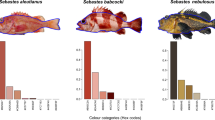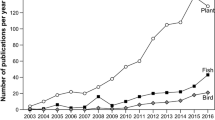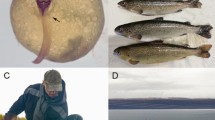Abstract
Natural populations are exposed to multiple stressors. These stressors may interact, leading to synergistic or antagonistic responses. In addition to these direct interaction effects, there may also be an interaction between stressors through a selection effect: as the population genetically responds to one stressor, it may become more vulnerable to another one, for instance because of an associated reduction in genetic variation. We here capitalized on a selection experiment involving the exposure of Daphnia populations to carbaryl pulses to test the hypothesis that selection imposed by this pesticide may increase vulnerability to fish predation in the resulting population. A direct predation experiment with individuals isolated from carbaryl-exposed and non-exposed populations revealed no effect of prior selection by carbaryl exposure on mortality due to stickleback predation.

Similar content being viewed by others
References
Barry, M. J., 2002. Progress toward understanding the neurophysiological basis of predator-induced morphology in Daphnia pulex. Physiological and Biochemical Zoology 75: 179–186.
Beauvais, S. L., S. B. Jones, S. K. Brewer & E. E. Little, 2000. Physiological measures of neurotoxicity of diazinon and malathion to larval rainbow trout (Oncorhynchus mykiss) and their correlation with behavioral measures. Environmental Toxicology and Chemistry 19: 1875–1880.
Bergelson, J., 1994. The effect of genotype and the environment on costs of resistance in Lettuce. The American Naturalist 143: 349–359.
Boersma, M., P. Spaak & L. De Meester, 1998. Predator-mediated plasticity in morphology, life-history and behavior of Daphnia: the uncoupling of responses. The American Naturalist 152: 237–248.
Boone, M. D. & S. M. James, 2003. Interactions of an insecticide, herbicide, and natural stressors in amphibian community mesocosms. Ecological Applications 13: 829–841.
Boone, M. D., R. D. Semlitisch, E. E. Little & M. C. Doyle, 2007. Multiple stressors in amphibian communities: effects of chemical contamination, bullfrogs, and fish. Ecological Applications 17: 291–301.
Bourguet, D., T. Guillemaud, C. Chevillon & M. Raymond, 2004. Fitness costs of insecticide resistance in natural breeding stress of the mosquito Culex pipiens. Evolution 58: 128–135.
Brewer, M. C., P. Dawidowicz & S. I. Dodson, 1999. Interactive effects of fish kairomone and light on Daphnia escape behavior. Journal of Plankton Research 21: 1317–1335.
Bridges, C. M., 1997. Tadpole swimming performance and activity affected by acute exposure to sublethal levels of carbaryl. Environmental Toxicology and Chemistry 16: 1935–1939.
Bridges, C. M., 1999. Effects of a pesticide on tadpole activity and predator avoidance behavior. Journal of Herpetology 33: 303–306.
Campero, M., S. Slos, F. Ollevier & R. Stoks, 2007. Sublethal pesticide concentrations and predation jointly shape life history: behavioral and physiological mechanisms. Ecological Applications 17: 2111–2122.
Carriere, Y., J. P. Deland, D. A. Roff & C. Vincent, 1994. Life-history costs associated with the evolution of insecticide resistance. Proceedings of the Royal Society of London Series B – Biological Sciences 258: 35–40.
Coors, A. & L. De Meester, 2008. Synergistic, antagonistic and additive effects of multiple stressors: predation threat, parasitism and pesticide exposure in Daphnia magna. Journal of Applied Ecology 45: 1820–1828.
Coors, A., E. Decaestecker, M. Jansen & L. De Meester, 2008. Pesticide exposure strongly enhances parasite virulence in an invertebrate host model. Oikos 117: 1840–1846.
Coors, A., J. Vanoverbeke, T. De Bie & L. De Meester, 2009. Land-use, genetic diversity and toxicant tolerance in natural populations of Daphnia magna. Aquatic Toxicology 95: 71–79.
Crawley, M. J., 1992. Natural enemies. The population biology of predators, parasites and diseases. Blackwell Scientific Publications, Oxford.
De Meester, L., 1993. Genotype, fish-mediated chemicals, and phototactic behavior in Daphnia magna. Ecology 74(5): 1467–1474.
De Meester, L., 1996. Evolutionary potential and local genetic differentiation in a phenotypically plastic trait of a cyclic parthenogen, Daphnia magna. Evolution 50: 1293–1298.
De Meester, L. & C. Cousyn, 1997. The change in phototactic behaviour of a Daphnia magna clone in the presence of fish kairomones: the effect of exposure time. Hydrobiologia 360: 169–175.
Guillemaud, T., T. Lenormand, D. Bourguet, C. Chevillon, N. Pasteur & M. Raymond, 1998. Evolution of resistance in Culex pipiens: allele replacement and changing environment. Evolution 52: 443–453.
Hoang, A., 2001. Immune response to parasitism reduces resistance of Drosophila melanogaster to desiccation and starvation. Evolution 55: 2353–2358.
Lampert, W., 1987. Predictability in lake ecosystems: the role of biotic intercations. In Schultze, E. D. & H. Zwölfer (eds), Ecological studies. Springer, Berlin/Heidelberg: 333–346.
Lass, S. & K. Bittner, 2002. Facing multiple enemies: parasitised hosts respond to predator kaïromones. Oecologia 132: 344–349.
McKenzie, J. A., M. J. Whitten & M. A. Adena, 1982. The effect of genetic background on the fitness of diazinon resistance genotypes of the Australian sheep bowfly, Lucilia cuprina. Heredity 49: 1–9.
Mucklow, P. T., D. B. Vizoso, K. H. Jensen, D. Refardt & D. Ebert, 2004. Variation in phenoloxidase activity and its relation to parasite resistance within and between populations of Daphnia magna. Proceedings of the Royal Society of London B – Biological Science 271: 1175–1183.
O’Keefe, T. C., M. C. Brewer & S. I. Dodson, 1998. Swimming behavior of Daphnia: its role in determining predation risk. Journal of Plankton Research 20: 973–984.
Pauwels, K., R. Stoks & L. De Meester, 2005. Coping with predator stress: interclonal differences in induction of heat-shock proteins in the water flea Daphnia magna. Journal of Evolutionary Biology 18: 867–872.
Peckarsky, B. L. & S. I. Dodson, 1980. An experimental analysis of biological factors contributing to stream community structure. Ecology 61: 1283–1290.
Relyea, R. A. & J. T. Hoverman, 2008. Interactive effects of predators and a pesticide on aquatic communities. Oikos 117: 1647–1658.
Relyea, R. A. & N. Mills, 2001. Predator-induced stress makes the pesticide carbaryl more deadly to gray treefrog tadpoles (Hyla versicolor). Proceedings of the National Academy of Sciences of the United States of America 98: 2491–2496.
Scott, G. R. & K. A. Sloman, 2004. The effects of environmental pollutants on complex fish behaviour: integrating behavioural and physiological indicators of toxicity. Aquatic Toxicology 68: 369–392.
Sih, A., A. M. Bell & J. L. Kerby, 2004. Two stressors are far deadlier than one. Trends in Ecology and Evolution 19: 274–276.
Tollrian, R. & C. D. Harvell, 1999. The ecology and evolution of inducible defense mechanisms. Princeton University Press, Ney Jersey.
Acknowledgements
Mieke Jansen enjoys a PhD fellowship of the “Institute for the Promotion of Innovation through Science and Technology in Flanders (IWT-Vlaanderen)”. This research was financially supported by project FWO.0269.04, FWO.0185.09 and G 022909.09 of the Fund for Scientific Research, Flanders (FWO), project GOA/2008/06 of the KULeuven research fund and EU-IP project ALARM.
Author information
Authors and Affiliations
Corresponding author
Additional information
Guest editors: M. Silva-Briano & S. S. S. Sarma / Biology of Cladocera (Crustacea): Proceedings of the VIII International Cladocera Symposium
Rights and permissions
About this article
Cite this article
Jansen, M., Stoks, R., Coors, A. et al. No evidence for a cost of selection by carbaryl exposure in terms of vulnerability to fish predation in Daphnia magna . Hydrobiologia 643, 123–128 (2010). https://doi.org/10.1007/s10750-010-0129-7
Published:
Issue Date:
DOI: https://doi.org/10.1007/s10750-010-0129-7




